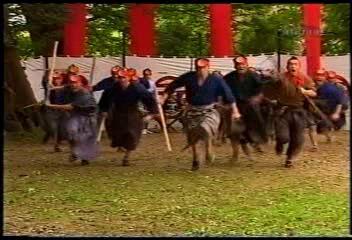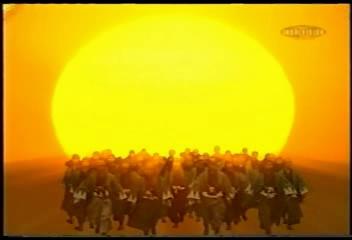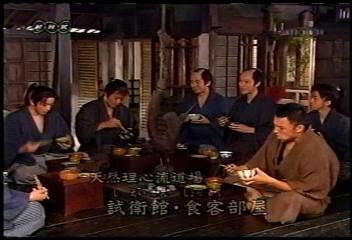(Background Music playing: Shinsengumi! Main Theme -kikou Version- by John Ken Nuzzo)
This is the place where I would introduce you about Shinsengumi ^-^ Might be the most boring section in this website coz it includes the historical background of Shinsengumi =P I was debating myself, whether I should or should not have this section...but, then I think historical background is necessary due to the fact that Shinsengumi is a real historical figure ^-^
What is Shinsengumi?
 Shinsengumi is known as Kyoto's guards team. In Edo, there's a dojo named Shieikan which use Tennen Rishin Ryuu style. The heir of the dojo is Isami Kondou and other disciples who trains in this dojo are Toshizou Hijikata, Souji Okita, Genzaburou Inoue....also disciples who later joined Shieikan too, are Keisuke Yamanami, Sanosuke Harada, Heisuke Toudou, and Shinpachi Nagakura.
Shinsengumi is known as Kyoto's guards team. In Edo, there's a dojo named Shieikan which use Tennen Rishin Ryuu style. The heir of the dojo is Isami Kondou and other disciples who trains in this dojo are Toshizou Hijikata, Souji Okita, Genzaburou Inoue....also disciples who later joined Shieikan too, are Keisuke Yamanami, Sanosuke Harada, Heisuke Toudou, and Shinpachi Nagakura.
Right after Isami and Hijikata heard there's going to be a roushi-tai, they and the other Shieikan disciples went to Kyoto to join the troops. After passing the test, they registered as samurai lead by Kiyokawa Hachirou. Then Isami-tachi, were appointed as Kyoto's guards by Katamori Matsudaira, an Aizu warlord, a Kyoto Shugosoku.
Kiyokawa is a cunning man, he is actually against bakufu, and secretly trained the roushi to be the troops for Meiji Restoration. Because what he did, Kiyokawa and his followers killed by pro-shogun people in the 3rd year of Bunkyuu. After the incident, Isami-tachi still want to serve to shogun, and joined forces with the name Miburoushi. But later, changed to Shinsengumi, due to the fact that some people diverge the kanji character of rou with rou character which means wolves(different character, same pronounciation). That's why, they were also nicknamed as Mibu Rou or Mibu no Ookami(both means Mibu Wolves). They were also called Hitokiri Oni(evil slayers). And the worst one was.....Dogusare Sukebee Rounin....^_^;
source: Animonster
re-written by Yanie
Historical Background
 In the 1860s, Japan was in tumult as the Tokugawa regime looked to be coming to an end. Anti-shogun feelings were running high following the capitulation to the Black Ships. "Revere the Emperor, expel the Foreigners" (sonnou joui!) was the slogan of the day.
In the 1860s, Japan was in tumult as the Tokugawa regime looked to be coming to an end. Anti-shogun feelings were running high following the capitulation to the Black Ships. "Revere the Emperor, expel the Foreigners" (sonnou joui!) was the slogan of the day.
To counteract supporters of the emperor, who had gathered in Kyoto, the shogunate set up a special police force who were recruited from amongst the leading swordsmen of Edo. But after being sent to Kyoto, many turned out to sympathise with the opposition. The group was disbanded, though a nucleus remained behind to continue.
The most prominent member was an arrogant samurai called Serizawa Kamo who took advantage of his position by running up debts, abusing women and picking fights. The gang had such a bad reputation that it was named "Mibu-rou," a wordplay referring to their base at Mibu which could mean either "Mibu ronin" or "Mibu wolves."
Serizawa was assassinated in an internal plot, thought to have been carried out by Kondo Isami and his right-hand man Hijikata Toshizo, who became the new leaders. Though not samurai themselves, they were dedicated men who believed in warrior ethics (bushido) and embodied the group's slogan: sincerity (makoto).
The group lived by a strict code, known as Gohatto. Amongst its stipulations was that once you became a member, you could never leave. Brotherhood was cherished, and private life came a distant second.
The most famous incident involving the Shinsengumi was that at Ikedaya (1864). Realising that an anti-shogun group was plotting assassinations, the Shinsengumi attacked the inn where the group was staying and routed them. Outstanding in this was master swordsman, Okita Souji. Nine years younger than Kondo and Hijikata, he was a handsome and dashing figure who had tuberculosis. Following this, the fame of the Shinsengumi spread, and recruits flocked to join them. Though they fought valiantly, the shogunate collapsed around them and they were driven out of Kyoto. Yet they continued to fight, even after the shogun himself had given up. In the end, almost all were killed or took their own lives.
absolute courtesy of Kansai Time Out
Shinsengumi's Appeal
 In a sense, the Shinsengumi were just a bunch of hit-men hired by a repressive regime. Assassination, arson, and surprise attacks were their stock in trade. Their favoured tactic was to overwhelm the enemy by force of numbers. So what makes the group so appealing? For one thing, the Japanese (like the British) are fond of heroic losers. (Think of Yoshitsune, hounded to death by Yoritomo.) In addition, the group were master swordsmen, a band of brothers, men sworn to defend their cause to the point of death - in short, they were everything that make ninja and samurai dramas so popular.
In a sense, the Shinsengumi were just a bunch of hit-men hired by a repressive regime. Assassination, arson, and surprise attacks were their stock in trade. Their favoured tactic was to overwhelm the enemy by force of numbers. So what makes the group so appealing? For one thing, the Japanese (like the British) are fond of heroic losers. (Think of Yoshitsune, hounded to death by Yoritomo.) In addition, the group were master swordsmen, a band of brothers, men sworn to defend their cause to the point of death - in short, they were everything that make ninja and samurai dramas so popular.
Added to this is that magical ingredient: early death. Kondo and Hijikata died in their mid-30s, Okita Souji is even younger, in 25 years of age. The Japanese fondness for cherry blossoms falling in their prime is often mentioned here, but early death has a universal appeal. The European Romantics were equally fond of the idea; as Byron wrote, "Whom the gods love die young." The Shinsengumi saga calls to mind that other great group story, "Chuushingura." There are similar elements: sacrifice, loyalty, secrecy, intrigue, bravery, and a tragic end. Even the mass suicide of the 47 Ronin is echoed in the 40 or so Shinsengumi who killed themselves (out of a total of some 240).
Chuushingura remains the classic of its type. But whereas middle-aged men get obsessed with the 47 rounin, it is often females who are fascinated by the "buddy" heroics of the dashing young Shinsengumi.
absolute courtesy of Kansai Time Out
My Interest in Shinsengumi
Indonesia, 2000. Is the place and the year where Watsuki Nobuhiro's Rurouni Kenshin animation became so popular in an instant! Most school boys & girls would watch it every Monday to Friday, 15.30 PM! Some school ended at 16.00 PM, so what will they do? Skip class, skip the last subject of that day....haha! ^_^ I am one of some, that have once or twice done this =P
I am an SMA Negeri 8, Bukit Duri, Jakarta graduate. I was an anime otaku since 3rd grade junior high, so I was very lucky to find a quite big community of anime fans in SMA 8 ^-^ The radio school for every Friday even played Japanese songs^^ I am not a fan of Rurouni Kenshin, but I've heard stories of it from my friends, so I watched some of the episodes...and I know that its a great anime...^-^ Oh, and althou I'm not a big fan of the anime, but I am a big fan of the themesongs!!^.^ Even until now, I still memorized which song is the 4th ending themesong and which song is the 2nd opening themesong....heheh......RK really has great themesongs!
Kenshin is a fictitious character, a pro-choushuu samurai, his boss is Katsura Kogoro, he is a very kind and nice man(totally opposite from the Katsura Kogoro in NHK's Shinsengumi =P). Being a choushuu samurai, Kenshin confronts Shinsengumi alot of times. Probably, most fierce fight he has, was with Okita Souji, the youngest yet the strongest member of Shinsengumi.
And this is when I see Shinsengumi for the first time. Kenshin and Katsura Kogoro were the protagonists of the story, so of course the Shinsengumi members are the antagonists ^_^ Despite the fact, that they are antagonists, its hard for Kenshin fans to hate them. Because they appear quite cool in the anime.....thus, most of Shinsengumi fans in Indonesia, are more and less, because they watched them in Rurouni Kenshin.... I was not a fan of RK, but I know it was a cool anime and Shinsengumi consists of cool figures....however, I was not yet interested to know further more.....
My interest grow bigger last year, when I got to know that my dai-ichiban ga suki na idoru is going to act in a taiga drama entitled Shinsengumi! and as the leading role, too!!^_~ I just gotta know what he's up to......so I try to find infos on Shinsengumi....and my interest on them get bigger and bigger. Especially, to find out that the taiga drama is so light-hearted with so many funny scenes...and also not just about rebellion or war, but also focus alot on the friendship, the brotherhood between Shinsengumi^^ Their appeal is that they grow up together in a dojo....then, they join forces in Shinsengumi....so the members relationship are more than just working mates....they are good friends... Well, I dunno....just really like the characters, and I think credits should go to the good script-writing of the drama^^
Anyway, in Japan itself, there are even a Shinsengumi fans club, which will meet every five years, mostly are senior people, I assume now ^_^ And I think there was also a Hijikata fans club....hmm, I predict the members are mostly women? ;)
Well......well.....no wonder NHK's Shinsengumi! got very good ratings! And one of the reason is also, Japan highschool teachers suggests their students to watch the historical drama! And of course, the students, esp. female ones, wont say 'no' to that......the taiga drama stars young and kakkoi actors!! What more can you ask??^_^ But, anyway, aside from those reasons....Shinsengumi! is really a good production overall......best taiga drama I've ever seen actually. Because I usually never enjoy taiga dramas.....but, this one I really love!!!!^_^
Keep fighting under the makoto, yoh!p^_^q